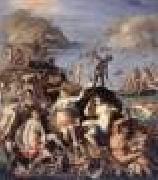|
|
 |
ZUCCHI Jacopo
|
|
Italian Painter, ca.1540-1596
Italian painter and draughtsman. He was trained in the studio of Vasari, whom he assisted in the decoration of the Palazzo Vecchio, Florence, as early as 1557. He accompanied Vasari to Pisa in 1561, from when dates his earliest known drawing, Aesculapius (London, BM). Between 1563 and 1565 he was again in Florence and is documented working with Vasari, Joannes Stradanus and Giovan Battista Naldini on the ceiling of the Sala Grande (Salone dei Cinquecento) in the Palazzo Vecchio; a drawing of an Allegory of Pistoia (Florence, Uffizi) is related to the ceiling allegories of Tuscan cities. In 1564 Zucchi entered the Accademia del Disegno and contributed to the decorations erected for the funeral of Michelangelo. He travelled to Rome with Vasari and was his chief assistant on decorations in the Vatican in 1567 and 1572, |
|
 |
ZUCCHI, Jacopo
|
|
Italian Painter, ca.1540-1596. Jacopo Zucchi was an Italian painter of the Florentine school. Italian painter and draughtsman. He was trained in the studio of Vasari, whom he assisted in the decoration of the Palazzo Vecchio, Florence, as early as 1557. He accompanied Vasari to Pisa in 1561, from when dates his earliest known drawing, Aesculapius (London, BM). Between 1563 and 1565 he was again in Florence and is documented working with Vasari, Joannes Stradanus and Giovan Battista Naldini on the ceiling of the Sala Grande (Salone dei Cinquecento) in the Palazzo Vecchio; a drawing of an Allegory of Pistoia (Florence, Uffizi) is related to the ceiling allegories of Tuscan cities. In 1564 Zucchi entered the Accademia del Disegno and contributed to the decorations erected for the funeral of Michelangelo. He travelled to Rome with Vasari and was his chief assistant on decorations in the Vatican in 1567 and 1572, |
|
 |
ZURBARAN Francisco de
|
|
Spanish Baroque Era Painter, 1598-1664
Spanish painter. He was apprenticed in 1614 to a painter in Sevilla (Seville), where he lived until 1658 when he moved to Madrid. He had a few royal commissions but remained throughout his life a provincial painter of religious pictures. His apostles, saints, and monks are painted with almost sculptural modeling, and his emphasis on the minutiae of their dress lends verisimilitude to their miracles, visions, and ecstasies. This distinctive combination of naturalism with religious sensibility conforms to the guidelines for Counter-Reformation artists outlined by the Council of Trent. He had numerous commissions from monasteries and churches throughout southern Spain, and many of his works were sent to Lima, Peru. |
|
 |
Zygmunt Waliszewski
|
|
(1897-1936) was a Polish painter, a member of the Kapist movement.
Waliszewski was born in Saint Petersburg to the Polish family of an engineer. In 1907 his parents moved to Tbilisi where Waliszewski spent his childhood. In Tbilisi began his studies at a prestigious art school. In 1908 he had his first exhibition and participated in the life of artistic avant-garde. During World War I he fought with the Russian army, returning to Tbilisi in 1917. He visited Moscow several times and became inspired by the Russian Futurists. He, later, became a member of a Futurist group. In the early 1920s, he departed for Poland, and settled in Krakew. Between 1921 and 1924 he studied at Academy of Fine Arts in Krakew in the studios of Wojciech Weiss and Jezef Pankiewicz. In 1924 he went to Paris with his avante-garde group and continued his studies in painting there under the guidance of Pankiewicz. He was a participant in the Capists' plein-air painting workshops in Cagnes, Valence, Cap Martin, and Avignon. At the Louvre, he painted copies and travesties of the works of old masters like Titian, Veronese, Velezquez, Vermeer, Goya, and Delacroix. He was also fascinated by the art of Cezanne, van Gogh, and Matisse.
In 1931 he returned to Poland, residing in Warsaw, Krzeszowice, and Krakew. During this time Waliszewski designed scenery and posters, created book illustrations, drew and painted caricatures and grotesque scenes. In Krakew he befriended the Polish Formists. Waliszewski painted primarily portraits and figural compositions and landscapes of the rural countryside. He died suddenly in 1936.
|
|
|

